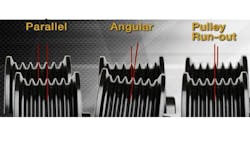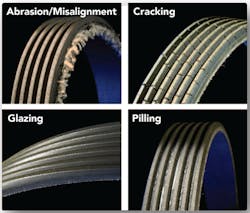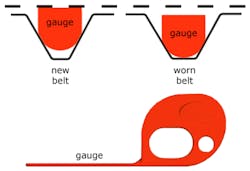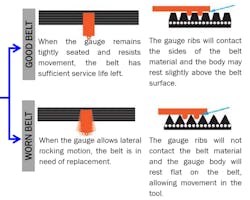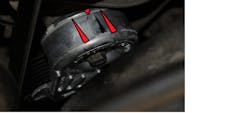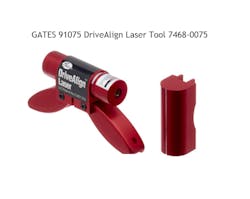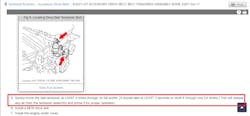Content brought to you by Motor Age. To subscribe, click here.
This article has been updated from its original April 2020 publication in Motor Age.
What You Will Learn:
• Drive belts rarely fail without an underlying cause
• Serpentine belts (made of EPDM) don't visually indicate wear, even after 100k miles
• A spray bottle of water will prove if belt noise is caused by either a slip or an alignment issue
We have all been here quite a few times. A 1997 model year vehicle is in the shop for routine service, along with the complaint of belt noise after a recently replaced alternator. A dry-rotted, shiny serpentine belt glistens beneath the glow of your inspection lamp. You reach down to manipulate the belt to confirm your suspicions. Upon twisting the belt, the surface area resembles more of the Grand Canyon than it does a drive belt.
You replace it due to its terrible condition and then it happens. The new belt is squeaking like a hungry church mouse, and we are quick to blame the parts house or the belt manufacturer because of the defective component they've supplied us with. We then decide it is just a good sport to replace the tensioner because, after all, what else could allow this brand-new belt to be so audible? Forty-minutes into attempt number two and the noise is still present! Realizing only late into the process that the new belt is exhibiting wear marks on the external edge, it becomes obvious that the new alternator pulley is distorted and appears to have been dropped or hammered into place.
Attack the problem professionally
This scenario is all too familiar, and I’ve seen it play out many times in years past. According to Bobby Bassett of Gates Corporation, 99.8 percent of all belts returned as defective are indeed the victims of a root-cause failure, and not the belt itself. This poses a big problem for the entire automotive service industry and parts industry as well.
If the shop making the claim is not acknowledged, it wouldn't be surprising if that shop sought parts supply elsewhere. So, the parts houses step up to the plate and perform the exchange. But who pays for all of this? In the end, no one is in business to lose money. At what point does the cost of the parts increase significantly to offset this loss?
Times are changing and this practice of returning parts that have not failed will not be as easy moving forward. There is much more to a simple serpentine belt inspection/replacement than hanging a new belt. Stick with me and you’ll discover why approaching the accessory drive belt system (ADBS) as a true “system” is just what is necessary to fix the vehicle right, the first time.
The ADBS is in place to serve a simple purpose — to transfer torque from the engine to the accessory systems (like the alternator, air conditioning compressor, water pump, and power steering pump, for example). As elementary as that goal may seem, the ADBS has to endure a relatively heavy load for a very long time. It carries out this task in two different ways. The first and primary job is to remove the slack in the belt that develops over time and maintain adequate tension as the belt wears. The second is to absorb torsional vibrations as each cylinder achieves combustion and as accessory demand changes.
The ADBS accomplishes this task through friction and is comprised of only a few components, common to all vehicles. The torsional vibration dampener is the pulley affixed to the crankshaft and serves as the driving member of the system. The crankshaft is coupled to the pulley with a rubber dampening element that absorbs vibrations from the accessories and combustion events. The idler pulley is a free-spinning pulley on which the belt travels to optimize belt routing and suppress flutter. It does this by reducing the distance between other accessories. Newer vehicles have alternator decoupler pulleys that serve as one-way roller clutches. By allowing the alternator to freewheel, it increases the lifespan of not only the alternator but the entire ADBS as well.
The tension provided by the tensioner wedges the ribs of the belt into the grooves of the pulley to create the friction necessary to overcome the load demands of the accessories combined. A tensioner lives a hard life and averages over a billion oscillations in a 100k mile period! It’s amazing how much load the accessories place on the ABDS. An ADBS operating a supercharged vehicle under full load can rob an engine of over 50HP! For a belt to maintain the kind of friction necessary to prevent slippage under those loads is no easy feat. It’s also imperative that the ADBS is functioning correctly to maintain longevity and keep the entire system operating trouble-free.
What is belt noise?
For the ADBS to operate properly friction has to be maintained, meaning no slippage is desired. The noise we hear from time to time is the noise from the rubber of the belt rubbing on a component (like a pulley) rather than rolling across and driving it. Belt noise is exhibited by either a squeal (sustained) or a chirp (rhythmic) and either of those clues point to a different issue.
Belt noise is a symptom and typically occurs due to loss of tension, as the real fault is an issue somewhere else in the ADBS system. This can occur for numerous reasons and it’s our job as technicians to determine the root cause of the noise. This can be carried out systematically and the analysis of belt wear can always lead us to a root-cause failure.
To adequately evaluate an ADBS system, we first have to realize that things are not as they used to be. Before the advent of the serpentine belt, we relied on V-belts to drive the accessory components. These belts required periodic adjustment and the systems took up a lot of space longitudinally within the engine compartments. Relative to their surface area, the V-belts provided little friction and at times were a nuisance because they tended to roll or flip. The upside is that if a belt failed or became displaced, the other accessories (that weren’t operated by that belt) still functioned.
As the industry transitioned from V-belts to the neoprene serpentine belts, we realized a lot of benefits. The new systems took up less space and provided better friction because the ribs of the belt/pulleys allowed for more surface-area frictional contact (Figure 1). The belts were more fuel efficient and lived a much longer life. Inspection was relatively easy as the belt would exhibit visible indicators of pending failure and reduced efficiency (Figure 2). The main failure characteristics of these serpentine belts include:
- Glazing = The shiny, glossy look to the rubber surface of the belt. This is caused by excessive heat build-up and is always the cause of a loss of tension
- Pilling = This occurs when the rubber drive-surface of the belt becomes disassociate and rolls up into little tar-like balls that collect on the surface of the belt and transfer to the pulleys. Typically caused by a source of contamination like engine oil, A/C compressor oil or antifreeze.
- Cracking = Due to heat and age, the rubber begins to dry-rot, get brittle and separate. It’s common for this to occur around 50-60k miles with most neoprene serpentine belts.
- Rib-Shear = As time goes by, cracking can lead to rib-shear, when the frictional-surface of the belt begins to fall off of the backing. This can also occur due to heavy wear on a particular spot on the belt, caused by a pulley alignment issue.
In with the new
Today’s belts are highly engineered and no longer comprised of neoprene, like their ancestors. The serpentine belts of today are made of a technologically advanced material known as ethylene propylene diene monomer-class rubber (or EPDM) and it is formulated to withstand heat and prevent dry-rotting, giving the belts a significantly more serviceable life. Where a neoprene belt typically lasts 50-60k miles before showing signs of wear, a belt made with EPDM can go 100,000 miles and still exhibit no visible evidence indicating a need for replacement. With that being said, our evaluation of the belts must change as well.
A simple visual inspection will not suffice. These newer belts don't fail or age like the neoprene belts and only lose only small amounts of material over time. But even a 5-percent loss of material can cause marginal operation of the accessories leading to complaints like poor A/C performance, for example. Careful inspection must be carried out to prevent these complaints from occurring.
Although this article is focused on the serpentine belt, it’s worth briefly mentioning the stretch-to-fit belts, as yet another technological advancement. It’s a one-time installation belt made with a compound called Polyamide, which gives the belt an elastic characteristic. It's known as a stretch-belt (as the nickname implies) because it is stretched to fit over the pulleys it is intended to drive. It requires a special tool to install the belt properly. The tool also has provisions to remove the belt, or the belt can simply be cut with a blade. Either way, the belt is not designed to be used more than once (You’ve been warned!).
The systematic approach
Addressing normal wear first (worth stating again), only a small loss of material is occurring,even at 100k miles of life. As the belts wear slowly, the surface of the belt disappears, and the ribs of the belt begin to sink deeper into the pulley. At about 5 percent to 10 percent wear, the surface of the belt can bottom out in the pulley and a loss in friction can occur.
There are tools available to detect this invisible wear and they serve as a simple-to-use "go/no-go" gauge. The tool is available in two different designs, one of which is easy to use with the belt removed from the vehicle. It's placed within the ribs of the belt and if the tool drops below the surface of the belt, it indicates belt replacement is required (Figure 3).
The other version of the tool is just as simple to use but with the belt still installed (Figure 4). The ribs of the tool engage the ribs of the belt. An attempt to “wiggle” the tool in a rotating fashion is then carried out. If this can be accomplished, too much wear is present, and the belt must be replaced. If the tool cannot be “wiggled,” there is still service life available for the serpentine belt.
Gaining diagnostic direction easily
Discussed earlier was the fact that noise occurs from a fault in the ADBS. Eliminating the noise permanently means fixing the actual problem, not just temporarily eliminating the noise (which is the result of the problem). A simple first step for resolving noise issues is to use the spray bottle test. Applying water to a noisy belt can reveal a lot about the nature of the fault.
When the belt is sprayed and the noise is then increased, it’s indicative of a tension-related issue. The water allows the friction to diminish further and intensifies the noise. If the noise is intermittently eliminated or reduced, it indicates an alignment related issue. In this scenario, the water serves as a lubricant between the noisy components. This will allow us as technicians, to focus our efforts in the appropriate areas, rather than wasting time and/or money, emptying the parts-cannon.
Tension-related issues can be due to an incorrectly sized belt, a worn belt or malfunctioning tensioner (or a combination of the two). Monitoring the wear markers on the tensioner is possible on some vehicles. It’s always worth a look to see if the extension of the tensioner still falls within limits (Figure 5). Observing the tensioner can reveal excessive oscillations and would suggest the tensioner and belt be replaced as a pair. They are designed with approximately the same lifespan.
Alignment-related noise faults fall into three different categories:
- Angular = Angular faults occur when bearings/bushings start to wear, either in an accessory pulley, idler pulley or tensioner pulley. Many times, as tensioners begin to fail and come apart, they allow for enough movement to cause angularly related noises and extreme belt wear. Bent mounting brackets will do the same.
- Runout = Runout occurs when a pulley is improperly mounted or bent /distorted. These issues typically cause a rhythmic chirp, rather than a constant squeal.
- Parallel (Offset) = Parallel faults occur when pulleys and/or components that the pulleys mount to are not aligned with the other pulleys. This places an additional load on the side of the belt and causes premature wear/belt failure. An offset of only 1 deg will cause an increase in belt temperature of over 30 degrees-F. This noise tends to be the loudest at the shortest pulley spans.
Knowing that these issues cause noise and premature failure is one thing, but detecting it can be quite a challenge, depending on the location/accessibility of the components in question (Figure 6). Thankfully, there are helpful tools available to eliminate the guesswork. The DriveAlign by Gates is a laser-emitting device designed to easily indicate both parallel and angular misalignment (Figure 7). Here is how it works:
The DriveAlign is first indexed within the ribs of an accessory component’s pulley, as a point of reference. The pulley is then rotated while the casted laser beam is monitored for where it strikes another pulley in the system. If the offset from the point of reference is not the same, parallel misalignment exists and must be corrected. If parallel misalignment is not present, the tool is then referenced to that other pulley, and the process is reversed. If the laser then falls at a point dissimilar to the point on the referenced pulley, the first component is not offset but crooked in its mounting, causing angular misalignment, and must be corrected for.
Some things never change
The multi-groove serpentine belts of today are still prone to the same root-cause failure as the belts of years passed. It’s no secret that a foreign substance like engine oil, transmission fluid, A/C compressor oil, antifreeze and power steering fluid will cause a loss of friction and a belt to slip. The contaminants can degrade the belt's integrity and cause an undesirable noise, loss of A/C performance, battery charging issues, MILs and even potentially dangerous situations like loss of power steering assist. It's imperative that the source of the leak as well as the reason why the leak occurred, is located and rectified during belt replacement.
What some techs fail to realize is improper service procedures will cause the same repercussions. For instance, a leaking camshaft seal is a common failure on many engines. Replacement of the seal will likely stop the leak but if the reason the seal failed to begin with was due to excessive crankcase pressure or even a scored camshaft sealing surface, a comeback is sure to follow.
A simple leaking water pump is also a common occurrence and can be easily replaced or not-so-easy in many engines. Technicians have been doing so for years. The issue is that the service procedures have not remained the same. There are steps of the process added to ensure component longevity, and must be followed. The procedure requires the installer to rotate the water pump impeller by hand, before installation. This distributes the lubricant from the seal, around the pump shaft evenly, before the pump comes in contact with any coolant. Not carrying this procedure will result in premature failure of the pump seal and coolant leakage is sure to follow.
I never wish to discount the importance of proper research either. The one thing many technicians fail to do (early in the process) is to research applicable TSBs (technical service bulletins). Considering the millions of alike vehicles on the road, chances are someone has encountered the evident noise issue before, and there is a countermeasure for the concern.
Not only is this a time saver but also an insurance policy to ensure the job is done properly the first time. Consider this example — a 2007 Toyota Corolla exhibited a noise after alternator replacement. After the visual inspection was carried out, a simple search of service information (using the keyword "Belt") left us with the information we desired. A potential clue from a TSB to the root cause of the noise (without getting our hands dirty).
It outlined an inspection procedure that would determine the need to replace not only the tensioner but the belt as well. Furthermore, it indicated in the replacement procedure, a need to fully stroke the tensioner a few times to bleed air from the tensioner assembly and prime the tensioner to do its job and remove slack from the belt (Figure 8). How bad could this have gone if the procedure wasn't followed properly? How many tensioners and/or belts would potentially be returned as "defective?”
Have a game plan and follow it
So, as you can see, regarding the visual inspection and proper replacement of the serpentine belt is a concept of the past. A level of complexity was added that simply can’t be ignored. We have to stop thinking of “belt-noise” as a belt issue and always consider the entire accessory belt drive system for the root cause of the noise fault.
The takeaway.... have a systematic approach for ADBS evaluation, consider the root cause of the fault, research TSBs early in the evaluation and always follow proper service procedures. Those components that we’re so quick to call “defects” will be diminished significantly, while your confidence in the quality of the parts and your customer’s confidence in the quality of your repair will increase many times over.
About the Author
Brandon Steckler
Technical Editor | Motor Age
Brandon began his career in Northampton County Community College in Bethlehem, Pennsylvania, where he was a student of GM’s Automotive Service Educational program. In 2001, he graduated top of his class and earned the GM Leadership award for his efforts. He later began working as a technician at a Saturn dealership in Reading, Pennsylvania, where he quickly attained Master Technician status. He later transitioned to working with Hondas, where he aggressively worked to attain another Master Technician status.
Always having a passion for a full understanding of system/component functionality, he rapidly earned a reputation for deciphering strange failures at an efficient pace and became known as an information specialist among the staff and peers at the dealership. In search of new challenges, he transitioned away from the dealership and to the independent world, where he specialized in diagnostics and driveability.
Today, he is an instructor with both Carquest Technical Institute and Worldpac Training Institute. Along with beta testing for Automotive Test Solutions, he develops curriculum/submits case studies for educational purposes. Through Steckler Automotive Technical Services, LLC., Brandon also provides telephone and live technical support, as well as private training, for technicians all across the world.
Brandon holds ASE certifications A1-A9 as well as C1 (Service Consultant). He is certified as an Advanced Level Specialist in L1 (Advanced Engine Performance), L2 (Advanced Diesel Engine Performance), L3 (Hybrid/EV Specialist), L4 (ADAS) and xEV-Level 2 (Technician electrical safety).
He contributes weekly to Facebook automotive chat groups, has authored several books and classes, and truly enjoys traveling across the globe to help other technicians attain a level of understanding that will serve them well throughout their careers.
